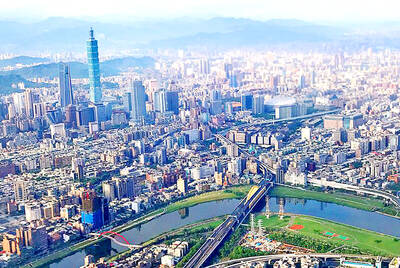Looking at objects from a close distance for long periods is a major cause of myopia in children and those who attend cram schools or after-school daycare centers are more likely to have worse eyesight, a study has found.
The study, published in the journal Ophthalmology, was jointly conducted by researchers from National Changhua University of Education, University College London, Taipei City Hospital, National Taiwan Normal University and National Taiwan University of Sports and other institutes, using statistics provided in the Ministry of Health and Welfare’s reports released once every four years.
One of the researchers, Ku Po-wen (古博文), a distinguished professor at National Changhua University of Education’s Graduate Institute of Sports and Health, on Monday said the study tracked changes in the eyesight of nearly 2,000 elementary-school children nationwide and found that the number of students with myopia increased by almost 30 percent over four years.
Most children who developed myopia attended a daycare center or cram school nearly everyday after school, where they attended more classes, did homework or took written tests, Ku said.
Each child on average spent 2.78 hours per day at a daycare center or cram school, he said, adding that the average time spent by a first and second-grade student at such an institute was 2.29 hours, while third and four-grade students spent 2.84 hours and fifth and sixth-grade students spent 3.1 hours.
The average time a child spent on the Internet or reading was estimated at 40 minutes per day, but the time they spent at daycare centers or cram schools was 4.5 times more than that, he said.
At school, children are required to take a 10-minute break following every 40-minute class and many would leave the classroom during those breaks, Ku said.
In contrast, at daycare centers or cram schools, children often have to read or look at objects from a close distance without taking any breaks for long periods of time, which significantly raises their risk of developing myopia, he said.
According to the ministry’s statistics, while less than 10 percent of kindergarten children have myopia, the percentage reaches 20 percent by the time they reach first grade and exceeds 70 percent by sixth grade, he said, adding that many children’s vision begin to significantly worsen in elementary school.
Looking at objects from a close distance for long periods of time — whether reading, drawing, playing with building blocks or using a smartphone — can cause myopia, Changhua’s Show Chwan Memorial Hospital ophtalmologist Kuan Pei-tzu (官珮慈) said.
Children’s eyeballs grow at a natural pace, but looking at objects from a close distance for long periods of time causes the eyeball’s axial length to grow too fast and give the eyeball an oblong shape, resulting in myopia, she said.

Taipei has once again made it to the top 100 in Oxford Economics’ Global Cities Index 2025 report, moving up five places from last year to 60. The annual index, which was published last month, evaluated 1,000 of the most populated metropolises based on five indices — economics, human capital, quality of life, environment and governance. New York maintained its top spot this year, placing first in the economics index thanks to the strength of its vibrant financial industry and economic stability. Taipei ranked 263rd in economics, 44th in human capital, 15th in quality of life, 284th for environment and 75th in governance,

The Sports Administration yesterday demanded an apology from the national table tennis association for barring 17-year-old Yeh Yi-tian (葉伊恬) from competing in the upcoming World Table Tennis (WTT) United States Smash tournament in Las Vegas this July. The sports agency said in a statement that the Chinese Taipei Table Tennis Association (CTTTA) must explain to the public why it withdrew Yeh from the WTT tournament in Las Vegas. The sports agency said it contacted the association to express its disapproval of the decision-making process after receiving a complaint from Yeh’s coach, Chuang

Control Yuan Secretary-General Lee Chun-yi (李俊俋) tendered his resignation last night, admitting that he had misused a government vehicle, as reported by media. His resignation was immediately accepted by the Control Yuan. In a statement explaining why he had resigned, Lee apologized for using a Control Yuan vehicle to transport his dog to a pet grooming salon on May 20. The issue first came to light late last month, when TVBS News reported that Lee had instructed his driver to take the dog to the salon. The news channel broadcast photos that it said were taken by an unnamed whistle-blower, which purportedly showed the

A former officer in China’s People’s Liberation Army (PLA) who witnessed the aftermath of the 1989 Tiananmen Square massacre has warned that Taiwan could face a similar fate if China attempts to unify the country by force. Li Xiaoming (李曉明), who was deployed to Beijing as a junior officer during the crackdown, said Taiwanese people should study the massacre carefully, because it offers a glimpse of what Beijing is willing to do to suppress dissent. “What happened in Tiananmen Square could happen in Taiwan too,” Li told CNA in a May 22 interview, ahead of the massacre’s 36th anniversary. “If Taiwanese students or